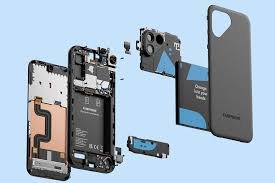Eco-Friendly Materials in Phones: Paving the Way to a Sustainable Future
In recent years, the smartphone industry has undergone rapid innovation, not just in technology but also in design and sustainability. As our devices become more advanced, we face the environmental impact of their production and disposal. Each smartphone contains metals, plastics, and glass that often end up in landfills or contribute to pollution. Fortunately, manufacturers have started adopting eco-friendly materials, marking a shift towards more sustainable practices. This article explores how these materials are being used and how they can reduce the environmental footprint of our phones. Check out the best Eco-Friendly Materials in Smartphones at Get Info For All.
The Environmental Impact of Traditional Phones
The journey of a traditional smartphone from the factory to our pockets is resource-intensive. Miners extract every phone’s various components made from rare minerals, like cobalt, lithium, and tungsten, at a significant environmental cost. These resources require energy-heavy processes for extraction, which contribute to greenhouse gas emissions, habitat destruction, and water pollution. Additionally, the use of plastics in phone casings and packaging generates waste that, when not recycled, lingers in the environment for centuries.
According to the United Nations, people recycle only 20% of the 50 million metric tons of electronic waste generated annually. The rest accumulates in landfills or incinerates, releasing harmful toxins into the soil and atmosphere. These realities have pushed manufacturers to re-evaluate their materials and production processes, leading to a surge in eco-friendly materials in recent smartphone models.

Key Eco-Friendly Materials in Modern Smartphones
- Recycled Plastics
Plastics are a staple in the smartphone industry, particularly for cases, internal components, and packaging. To reduce plastic waste, companies like Samsung and Apple are incorporating post-consumer recycled plastics in their devices. Recycled plastics require less energy to produce than virgin plastics and help divert plastic waste from landfills. For example, Samsung’s Galaxy S21 series used recycled plastic materials in its components, signaling a commitment to reduce its environmental impact. Additionally, Apple’s iPhone 12 was one of the first mainstream models to use 100% recycled rare earth elements in its magnets. - Recycled Aluminum and Stainless Steel
Metals like aluminum and steel are durable, making them ideal for phone frames and casings. By using recycled aluminum and stainless steel, manufacturers reduce the need for mining raw materials, which in turn conserves energy and decreases carbon emissions. Apple has been at the forefront of this shift, with its iPhone lineup using 100% recycled aluminum in its enclosures since 2018. Using recycled aluminum not only preserves natural resources but also reduces the device’s overall carbon footprint.
Key Eco-Friendly Materials in Modern Smartphones
- Biodegradable and Plant-Based Materials
Some companies are experimenting with biodegradable materials for phone cases and packaging, using plant-based materials like corn starch or bioplastics. These materials break down more easily in the environment compared to traditional plastics. Nokia, for instance, has explored biodegradable materials in its packaging, while other brands have introduced plant-based or compostable phone cases that provide consumers with a more eco-friendly option. These innovations represent a small but promising step towards reducing long-term waste associated with smartphone use. - Recycled Glass
The glass on our screens and back casings is another significant component of a smartphone. Companies are now using recycled glass in their production process, which helps save energy and raw materials. The Corning Gorilla Glass, widely used for its durability, has also introduced models incorporating recycled glass content, reducing the environmental toll of glass production. This glass, when recycled, provides a similar level of strength and clarity, proving that sustainable materials need not compromise quality. - Bioplastic Circuit Boards and Eco-Friendly Adhesives
Circuit boards are essential to a smartphone’s functionality, and traditionally, manufacturers compose them using petroleum-based plastics. However, brands are experimenting with bioplastics derived from renewable sources like corn and soybeans, which biodegrade and are less harmful to the environment. Furthermore, eco-friendly adhesives replace toxic adhesives to bind various components, preventing the release of harmful compounds when heated or disposed of improperly.
The Role of Modular Design and Repairability
In addition to material choices, phone manufacturers are also rethinking product design. Modular design allows users to replace or upgrade specific parts of their phones, like the battery or camera, rather than disposing of the entire device. Brands like Fairphone have pioneered this approach, offering a smartphone that’s easy to disassemble and repair. This philosophy encourages longer device life spans, reducing the frequency of replacements and, consequently, the demand for new materials.
Furthermore, modular designs promote a circular economy within the tech industry, where products are reused and recycled rather than discarded. Fairphone’s commitment to replaceable parts and transparent sourcing exemplifies a powerful shift towards responsible consumer electronics. While modularity may not be standard in every phone due to technical challenges, the success of companies like Fairphone demonstrates consumer demand for repairable, sustainable devices.
How Major Players Are Leading the Change
- Apple
Apple has made significant strides in its sustainability journey, aiming to make all products carbon-neutral by 2030. With each new iPhone model, Apple increases its use of recycled materials, including 100% recycled rare earth elements in its magnets. The company also offers a trade-in program that allows users to return their old devices for recycling or refurbishment, further reducing waste. Apple’s environmental reports highlight that 45% of its overall product components are now made from recycled materials, a number expected to increase. - Samsung
Samsung has joined the eco-friendly initiative with its Galaxy series, incorporating recycled plastics in select models and reducing packaging waste. The company’s Galaxy S22 used recycled fishing nets in its construction, addressing ocean pollution and creating a new pathway for sustainable production. Samsung has also set a target of using 100% renewable energy in its factories by 2025, demonstrating a strong commitment to reducing its carbon footprint. - Google
Google has made sustainability a core part of its Pixel phone lineup. For instance, the Pixel 5 featured an aluminum back cover made entirely from recycled materials, which eliminated the need for a plastic backing. Google also commits to carbon-neutral shipping and partners with environmental organizations to offset emissions associated with device production and delivery. - Fairphone
As one of the pioneers of eco-friendly smartphones, Fairphone has focused on ethical sourcing, fair labor practices, and modular design. The Fairphone 4, for example, is constructed from conflict-free minerals and recycled materials and is designed to last for at least five years. The company’s transparent supply chain and fair trade practices make it a standout in the industry for consumers seeking a truly eco-conscious device.
Consumer Role in the Shift to Eco-Friendly Phones
As consumers, we have the power to drive this change by supporting brands that prioritize sustainable practices. Opting for eco-friendly smartphones or devices with recycled materials sends a message to manufacturers about the importance of sustainability. Additionally, taking care of our devices to extend their lifespan, using repair services instead of discarding broken devices, and recycling old phones are small actions that collectively make a big difference.
Another way to support eco-friendliness is through the selection of sustainable phone accessories, like compostable cases or chargers made from recycled materials. By choosing accessories that align with sustainable values, consumers can contribute to a broader movement toward reducing electronic waste.
Conclusion: The Future of Eco-Friendly Smartphones
The journey toward a fully sustainable smartphone industry is underway, with eco-friendly materials and modular designs paving the path to a cleaner future. Companies like Apple, Samsung, Google, and Fairphone are spearheading this transformation by rethinking their materials, design philosophies, and recycling practices. While we still need to make progress, the growing momentum is driven by consumer demand and environmental urgency. Check out the best Eco-Friendly Materials in Smartphones at Get Info For All.
As we look to the future, the widespread adoption of eco-friendly materials and designs in smartphones could reduce the environmental toll of electronic devices significantly. By choosing sustainable options, supporting recycling initiatives, and encouraging more companies to prioritize eco-consciousness, we can all contribute to a more sustainable world, one smartphone at a time. The next time you upgrade your device, consider an eco-friendly option and join the movement toward a greener, smarter future. Check out the best Eco-Friendly Materials in Smartphones at Get Info For All.


